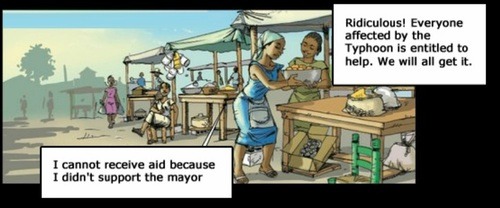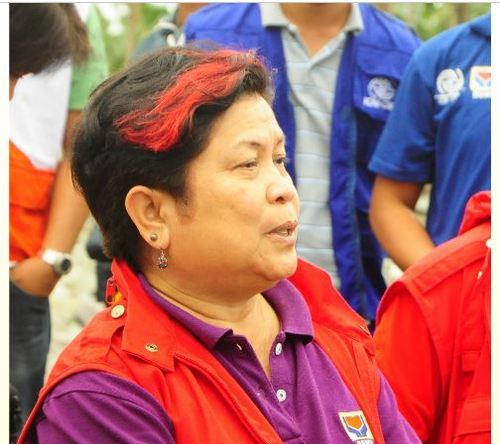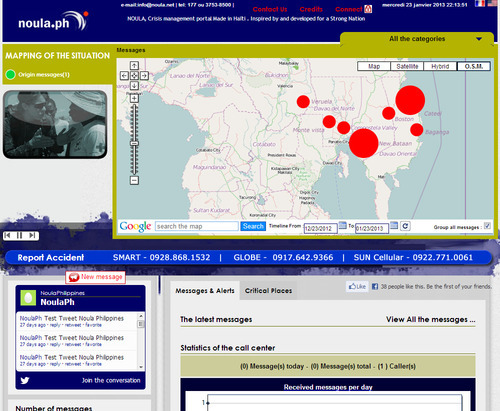
 By Leonard Doyle, in New Bataan, Mindanao
By Leonard Doyle, in New Bataan, Mindanao
The world shrugged with indifference when a deadly typhoon slammed into Mindanao in the Philippines a mere six weeks ago. It brought to mind Claud Cockburn’s infamously ironic headline “Small Earthquake in Chile, Not many dead”.
A few days later, as the clouds parted and waters receded the scale of the Mindanao disaster became clear: more than 1,500 dead, some 300,000 families homeless. More than that, the capacity of entire communities to sustain themselves was wiped out because coconut groves (that take up to 15 years to replenish) were flattened. A quarter of the entire banana producing area of the Philippines was also wiped out.
IOM, (alongside UN agencies, Red Cross and the Government of the Philippines), was one of the first agencies to respond in getting emergency aid to those affected by the typhoon. A project driven agency, the organization excels at efficient and effective delivery of aid to the most vulnerable victims of disasters.
In only four weeks families were moving into newly built wooden shelters and others had received lumber (sawn up coconut trees), nipa palm shingle and amakan (bamboo matting) for wall construction at displacement sites. Donors were responsive (the UN, Republic of Korea, Canada) and have already given over US$3 million towards IOM’s appeal of over $7 million.
But what has yet to be funded is a UN-approved appeal to support communications with the affected communities. When the priority is helping desperate families survive, communications usually plays second fiddle to NFI as bean counters so un-poetically describe emergency aid.
Its no surprise that communications aid was given short shrift in the Bopha appeal and that it remains unfunded.
All that may change following a troubling (but predictable) event at the town of Montevista recently when about 4,000 angry people in the sometimes restive province of Mindanao, created a noisy roadblock to stop a cortege of government dignitaries and donors. The redoubtable Filipina Aid Minister, Dinky Soliman, got out of her car and waded fearlessly into the crowd to see what was going on:”Hadn’t the government been working flat out, round the clock with the international community since the disaster to deliver aid?”

The aid had been delivered, but somehow the population didn’t know about it. The protesters angrily said no food-aid had been received and demanded 10,000 bags of rice to save the population from starvation.
The protest was a wake-up call for all concerned, because misunderstandings in Mindanao can quickly become deadly and escalate out of control. This is the last thing anyone wants, as there’s an active government supported reconciliation process underway in the region.
Ms Soliman was quick to react, declaring that she sees communication as aid. “ I am asking the international community to improve access to information - to give as much detail to people as you can. Don’t worry about overwhelming people.” As she explained: “Communication is also about managing community tensions and minimizing the capacity of those with political agendas to exploit and manipulate any misunderstandings and frustrations over assistance.”
“We need to work based on the point of view of those affected, and listen to them,” the minister concluded. This was music to the ears of anyone involved in communications. It was very public recognition for a long campaign by UNOCHA’s Imogen Wall, to put community communications at the heart of every emergency response worldwide.
Those at the sharp end of the relief effort in Mindanao agree. Joan Pintal, a local government information officer, deals with frustrated homeless people in the badly hit community of Monkayo every day. “By communicating openly and often about the aid process, we have managed to avoid the sort of dangerous situations they faced in Montevista,” she told me. “I have a one page information sheet which I hand out and it works wonders,” she said.

Communications dashboard created for Mindanao by Noula, a Haitian NGO
IOM Philippines has extensive experience in communications, as it happens. After a similarly deadly typhoon hit nearby Cagayan De Oro, last year the organization produced bi-weekly newsletters that were then the subject of extensive focus group discussions. However that was for an urban setting with high levels of literacy.
The latest typhoon to hit Mindanao (only the second typhoon at these latitudes in 21 years) struck isolated rural areas of Eastern Mindanao. This is an area of great poverty and low literacy. It’s also an area where communist rebels have been active for years and where trouble often hovers just over the horizon.
To head off any unpleasantness, IOM is working with the government and other interested parties to improve the information flow to the area. Part of that effort will involve a hotline for people to call or text about their needs. Noula, a Haitian NGO has stepped in to design and donate a communications dashboard which will ensure that all the information gathered is crowd-sourced, mapped and available to policy makers and the media.
A cartoonist who worked with IOM in Haiti is about to start working with Filipino cartoonists to adapt his work to the local context. “Filipinos aren’t great readers,” said Emm Obenieta, another information officer who works with displaced people in Mindanao, “so what we really want is graphic art, like comics to deliver important information.”

Christie Bacal, IOM information focal point in Mindanao
Christie Bacal was at home in Cagayan De Oro when the typhoon struck a year ago. “I woke up to the screams of neighbors; nothing like this had ever happened in our community.”
“People were shocked and really didn’t know what had happened. There was no electricity and of course our cell phones were dead; disaster,” she recalled.
“I learned right there and then that information is a form of aid in an emergency,” she said. A year later Christie is IOM’s information focal point for the latest emergency. She’s spearheading the effort to mainstream communications. What she needs now are the resources to harness the energy of the community and ensure that its concerns are heard.
Watch the Prezi: http://tinyurl.com/PablometBopha
Leonard Doyle is the head of Online Communications for IOM